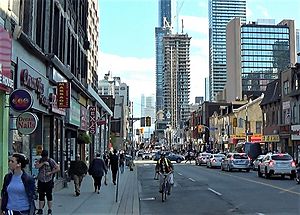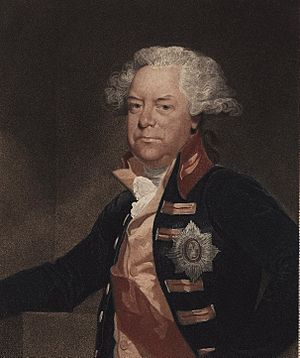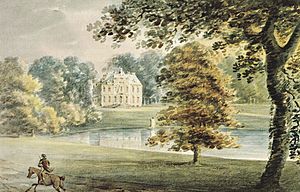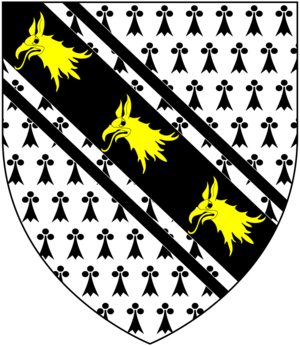Sir George Yonge, 5th Baronet facts for kids
Sir George Yonge, 5th Baronet (born 17 July 1731 – died 25 September 1812), was an important British politician. He came from Escot House in Devon, England. He served as the Secretary at War (a government job dealing with the army) twice, from 1782 to 1783 and again from 1783 to 1794.
Sir George inherited his father's special title, a "baronetcy," in 1755. This title ended when he passed away because he did not have any children. He is remembered today because a major road in Canada, Yonge Street in Toronto, was named after him in 1793. This was done by John Graves Simcoe, who was the Lieutenant-Governor of Upper Canada at the time.
Contents
Sir George Yonge's Life and Career
George Yonge was born in 1731 at Great House in Colyton, Devon. His father was Sir William Yonge, 4th Baronet. George was the son of his father's second wife, Ann Howard. He also had an older stepbrother named Walter.
He went to school at Eton College and then studied at the University of Leipzig in Germany.
Serving in Parliament
Sir George became a Member of Parliament for his family's area, Honiton, in Devon. He served from 1754 to 1761 and again from 1763 to 1796.
Honiton was known as a "Rotten Borough." This meant that elections there were often unfair. People would sometimes pay voters to choose a certain candidate. Sir George once said that he had inherited a lot of money and gained more when he married and from Parliament, but Honiton "swallowed it all." This was because of the large amounts of money spent on these unfair elections.
Important Roles and Honors
In 1782, Sir George was made a member of the Privy Council of the United Kingdom. This group advises the King or Queen. He also served as Governor of the British Cape Colony (a part of South Africa) for a short time from 1799 to 1801.
In 1784, he was chosen to be a Fellow of the Royal Society, which is a special group for important scientists. In 1788, he received a high honor and was made a Knight of the Bath.
Escot House
In 1755, Sir George inherited Escot House after his father passed away. In 1794, he sold the house to Sir John Kennaway, 1st Baronet. Sadly, Escot House later burned down in 1808.
Sir George Yonge passed away on 25 September 1812, at Hampton Court. He owed money when he died, and because he had no children, his baronetcy title ended with him. He was first buried where he died, but later his body was moved by sea to his family's burial place in Colyton.
Sir George Yonge's Family
Sir George Yonge married Ann Cleeve on 10 July 1765. He was 34 years old, and Ann was around 20 or 21. Ann's father had made some rules about her inheritance before he died, but it's not clear if these rules affected Ann's marriage to Sir George.
Ann and Sir George did not have any children. Ann passed away on 7 January 1833.
Sir George Yonge's Legacy

Sir George Yonge was known for his knowledge about ancient Roman roads. He was a member of the Royal Society and the Society of Antiquaries, where he shared his research on Roman roads and camps. This interest made it fitting that a major road was named after him.
Yonge Street in Canada
Yonge Street is a very important road in Toronto, Canada. It was built between 1795 and 1796. It originally went from Eglinton Avenue to Lake Simcoe. Later, the road was extended south to Bloor Street and then all the way to Lake Ontario.
Other places also named after him include Yonge Mills Road and Townline Road Escott Yonge in Front of Yonge Township near Mallorytown, Ontario.




